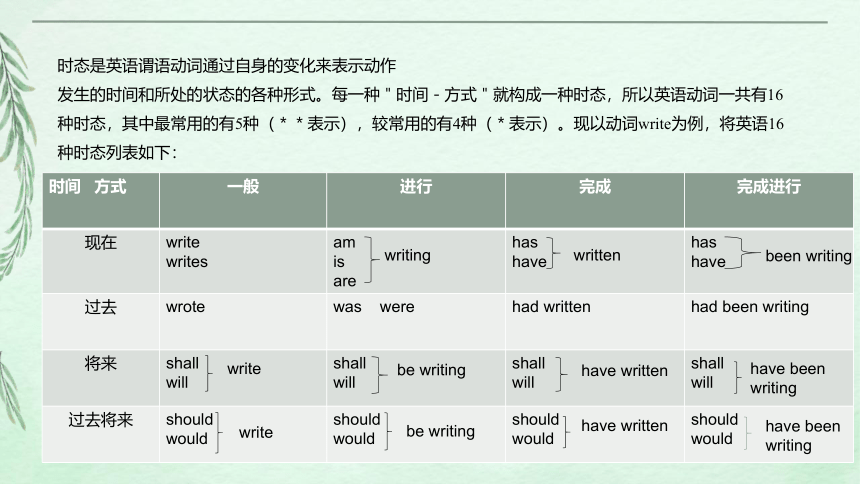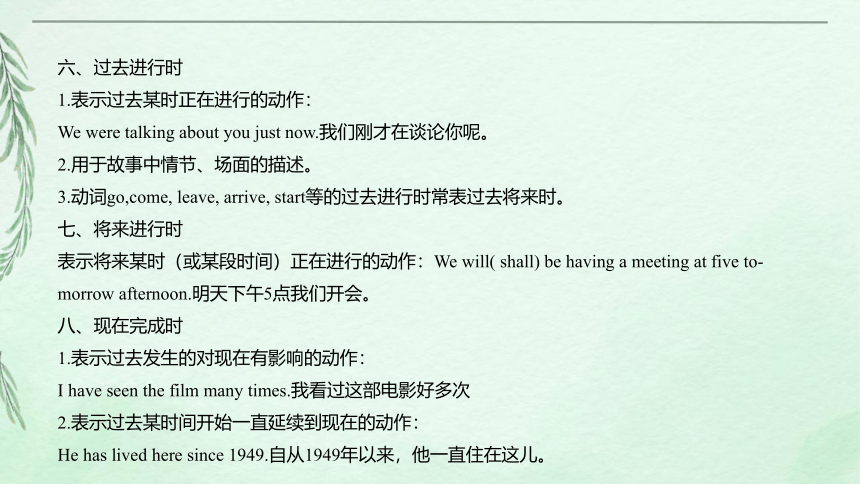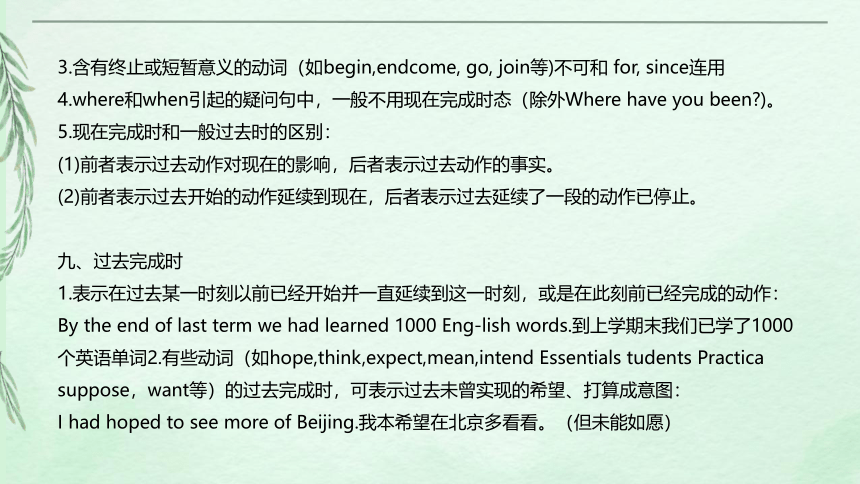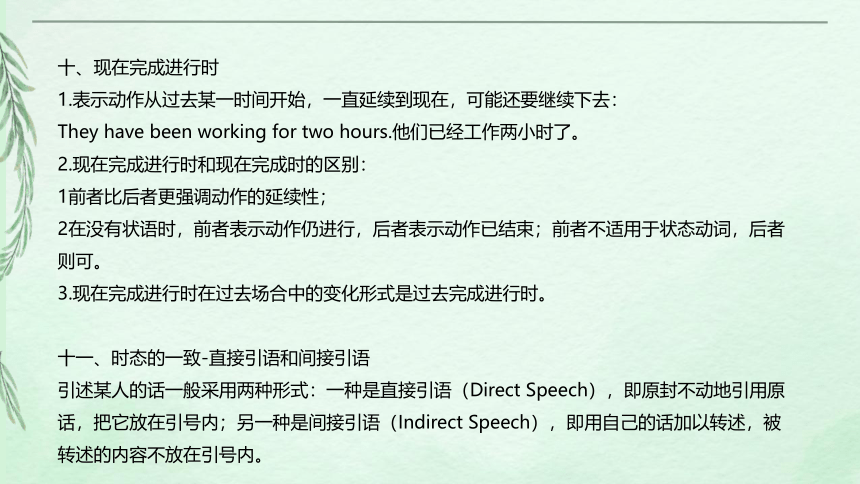2023届高考英语二轮复习动词的时态 课件(共22张PPT)
文档属性
| 名称 | 2023届高考英语二轮复习动词的时态 课件(共22张PPT) |  | |
| 格式 | pptx | ||
| 文件大小 | 4.1MB | ||
| 资源类型 | 教案 | ||
| 版本资源 | 通用版 | ||
| 科目 | 英语 | ||
| 更新时间 | 2023-06-02 11:13:48 | ||
图片预览









文档简介
(共22张PPT)
动词的时态
时态是英语谓语动词通过自身的变化来表示动作
发生的时间和所处的状态的各种形式。每一种"时间-方式"就构成一种时态,所以英语动词一共有16种时态,其中最常用的有5种(**表示),较常用的有4种(*表示)。现以动词write为例,将英语16种时态列表如下:
时间 方式 一般 进行 完成 完成进行
现在 write writes am is are has have has have
过去 wrote was were had written had been writing
将来 shall will shall will shall will shall will
过去将来 should would should would should would should would
writing
written
been writing
write
write
be writing
have written
have been writing
be writing
have written
have been writing
2.一般过去时:
(1)表示过去某时间的动作或状态。
(2)在时间、条件状语从句中代替过去将来时: He said when she came he would tell her.他说她来时就告诉她。
三、一般将来时
1.在英国第一人称用shall,其他人称用will;在美国所有人称均用will。
2.表示将来某一时刻的动作或状态,或将来某一段时间内经常的动作或状态。
3.有6种表示将来的形式,其区别为:
(1)will do和shall do多指客观上将要发生的动作等。
(2)be going to do表示打算去做或可能发生的事。
(3)betodo表示计划好的事情。
(4)be about to do表示即将(正要)做某事;要发生的动作。
(be todo可用于条件句,而表“将来”的will则不行。
四、一般过去将来时
1.在英国第一人称用should,其他人称用 would在美国,所有人称均用would。
2.表示从过去某时看,将要发生的事情:
He said he would be there soon.他说他很快就到那儿。
3.和一般将来时一样,过去将来时也有相应的was(或 were)+to do, was(或were)+(about+)to do等形式。
五、现在进行时
1.表示此时此刻或现阶段正在进行的动作:
He i having a meeting now.他正在开会。
2.动词go,come,leave,arrive,start等的现在进行时表示将要发生的动作。
3.表示感觉、情感、看法、愿望、心理状态、所有关系或特征等的状态动词(如hear,love, think,wishforget, own, have, be等)一般不用进行时。
六、过去进行时
1.表示过去某时正在进行的动作:
We were talking about you just now.我们刚才在谈论你呢。
2.用于故事中情节、场面的描述。
3.动词go,come, leave, arrive, start等的过去进行时常表过去将来时。
七、将来进行时
表示将来某时(或某段时间)正在进行的动作:We will( shall) be having a meeting at five to-morrow afternoon.明天下午5点我们开会。
八、现在完成时
1.表示过去发生的对现在有影响的动作:
I have seen the film many times.我看过这部电影好多次
2.表示过去某时间开始一直延续到现在的动作:
He has lived here since 1949.自从1949年以来,他一直住在这儿。
3.含有终止或短暂意义的动词(如begin,endcome, go, join等)不可和 for, since连用
4.where和when引起的疑问句中,一般不用现在完成时态(除外Where have you been )。
5.现在完成时和一般过去时的区别:
(1)前者表示过去动作对现在的影响,后者表示过去动作的事实。
(2)前者表示过去开始的动作延续到现在,后者表示过去延续了一段的动作已停止。
九、过去完成时
1.表示在过去某一时刻以前已经开始并一直延续到这一时刻,或是在此刻前已经完成的动作:
By the end of last term we had learned 1000 Eng-lish words.到上学期末我们已学了1000个英语单词2.有些动词(如hope,think,expect,mean,intend Essentials tudents Practica suppose,want等)的过去完成时,可表示过去未曾实现的希望、打算成意图:
I had hoped to see more of Beijing.我本希望在北京多看看。(但未能如愿)
十、现在完成进行时
1.表示动作从过去某一时间开始,一直延续到现在,可能还要继续下去:
They have been working for two hours.他们已经工作两小时了。
2.现在完成进行时和现在完成时的区别:
1前者比后者更强调动作的延续性;
2在没有状语时,前者表示动作仍进行,后者表示动作已结束;前者不适用于状态动词,后者则可。
3.现在完成进行时在过去场合中的变化形式是过去完成进行时。
十一、时态的一致-直接引语和间接引语
引述某人的话一般采用两种形式:一种是直接引语(Direct Speech),即原封不动地引用原话,把它放在引号内;另一种是间接引语(Indirect Speech),即用自己的话加以转述,被转述的内容不放在引号内。
陈述句的间接引语
直接引语是陈述句,变为间接引语时,在多数情况下都构成一个that引导的宾语从句,引述动词通常是say, tell等。与此同时,间接引语中的人称、时态和其他方面也要相应有所变化。
The foreigner aid to me, I like Beijing very much.那老外告诉我:我很喜欢北京。
→ The foreigner told me that he she liked Beijing very much. 那老外告诉我说他(她)很喜欢北京。
疑问句的间接引语
1.一般疑问句和反意疑问句
一般疑问句改为间接引语时,要用陈述语序,并要加连词if 或 whether,其主句动词常用ask, wonder, wantto know, didn't know等。句末不用问号。
You haven't been to Beijing, have you asked he. 他问:你没去过北,是吗?
→ He asked me ifwhether I had been to Beijing. 他问我是否去过北京。
2.否定的一般疑问句和选择问句
如果直接引语为否定的一般问句或选择疑问句时,用whether or 连接。
She said, Don't you know my telephone number 她说:你难道不知道我的电话号码吗?
→ She asked me whether I knew her telephone number or not. 她问我是知道她的电话号码。
3.特殊疑问句
间接引语为特殊疑问句时,间接引语前仍然用特殊疑问词作为连词引导宾语从句,注意从句必须用陈述语序,主句谓语动词常用ask。
How many books do you have she asked. 她问:你有多少本书?
→ She asked me how many books I had. 她问我有多少本。
英语中有些疑问句并非提出疑问,而是表示请求、劝告、建议等。这种疑问句变为间接引语时,往往采用其他的形式。
①.suggest doing
Shall we all go to the film tonight said Michael. 迈克尔说:我们今晚都去看电影,好吗?
→ Michael suggested going to the film tonight. 迈克尔建议今晚都去看电影。
What about having a drink he asked. 他问:喝杯怎么样?
He suggested having a drink. 他建议喝一杯。
②.advise sb to do
Why don't you go hiking asked James. 詹姆士问:你为什么不徒步旅行?
James advised me to go hiking. 詹姆士建议我去徒步旅行。
③. offer to do
He said, Would you like me to post the letter 他说:你要我寄信吗?
He offered to ost the letter. 他主动提出寄信。
④.ask sb to do
Will you please bring your reference book here tomorrow she said to me. 她对我说:劳驾你明天把你的参考书带来好吗?
→ She asked me to take my reference book there the next day. 她让我第二天把我的参考书带去。
祈使句的间接引语
1.直接引语为祈使句时,间接引语往往用复合宾来表示,其结构为主语+谓语+宾语+宾语补足语(动词不定式)。引述动词可根据口气选用tell, ask, order, command, request等词,句中please去掉。
She said to me, Please have a rest. 她对我说:请休息一下。
→ She asked me to have a rest. 她要求我休息一下。
2.带有let的祈使句(表示请求,建议或命令),可用suggest + -ing形式或suggest +that从句来表示其相应的意思。
Let's go for a walk, said the girl. 那姑娘说,让我们去散散步吧。
→ The girl suggested going for a walk. 这女孩建议去散散步。
The teacher sai, Let Lily tidy the classroom. 老师说:让莉莉整理教室。
→ The teacher suggested that Lily should tidy the classroom. 老师建议让莉莉整理教室。
D. 感叹句的间接引语
1.直接引语是感叹句变为间接引语时,多采用宾语从句结构,既可用what或how引导,也可用that引导。
What a clever boy you are!my teacher said to him. 老师对他说,你是个聪明的孩子啊!
→ My teacher told him what a clever boy he was. 老师对他说他是一个多聪明的孩子啊。
→ My teacher told him that he was a very clever boy. 老师说他是一个非常聪明的孩子。
2.有些感叹句可以根据原句的意思,采用适当的动词变为陈述句,不需用间接宾语来转述。
Help! he cried. 他喊到:救命啊! → He called for help. 他大声呼救。
连续概念与性质
连续概念与性质
二、 间接引语中的词语变化
直接引语变为间接引语时,间接引语中的动词时态、人称代词、物主代词、指示代词、时间和地点状语以及主谓语词序往往要作相应的变化。
A. 时态的变化
1.时态的变化
①现在时间推移到过去时间
直接引语中的时态:一般现在时-现在完成时-现在进行时-现在进行时-现在完成进行时-间接引语中的时态-一般过去时-过去完成时-过去进行时-过去完成进行时
He said, Is it raining
→ He asked if it was raining. 他问是不是正在下雨。
②过去时间推移到过去的过去
直接引语中的时态:一般过去时-过去完成时-过去进行时
间接引语中的时态:过去完成时-过去完成时(不变)-过去完成进行时或不变
What were you doing at seven p.m. yesterday he asked
→ He asked me what I was doing at seven p.m. the day before. 他问我前一天晚上七点在干什么。
③将来时间推移到过去将来时间
直接引语中的时态:一般将来时
isamare going to do isamare to do
间接引语中的时态:过去将来时
waswere going to do waswere to do
He said, We shall get ready by eight o'clock.
→He said that they ould get ready by eight o'clock. 他说他们将在8点前准备好。
We are to meet at the school gate, she said to me.
→ Sh told me that they were to meet at the school gate. 她告诉我他们约定在校门口见面。
④间接引语中保持原来时态不变
在下列情况下,间接引语中的谓语动词时态可以保持不变。
a. 主句为现在时或将来时,间接引语的时态保持不变。
He thinks, She will be back in a month.
→ He thinks she will be back in a month. 他想她将在一个月后回来。
He says, I have accepted her invitation.
He says he has accepted her invitation. 他说他已接受了她的邀请。
比较:
间接引语中的谓语动词时态对比。
Sarah said to me,I have two brothers. 莎莎对我说:“我有两个弟弟。”
Sarah told me that she has two brothers. 莎莎告诉我说她有两个弟弟。(说话才认为这情况是真实的)
Sarah told me that she had two brothers. 莎拉告诉我说她有两个弟弟。(说话者对此没有什么把握)
b. 间接引语表示的是现在的习惯动作、科学真理、客观事实、格言等。
The geography teacher said to the students, The earth moves round the sun.
→ Th geography teacher told the students that the earth moves round the sun. 老师告诉学生地球围绕太阳转。
He said, Every dog has his day.
→ He said that every dog has his day. 他说是人皆有出头日。
2.情态动词的变化
情态动词在间接引语中都可以改为过去式,must表示必、推测、禁止等意思时,可不变;表示必须时可不变,也可用had to 或would have to。
The senior said, All men must die.
→ The senior said that all men must die. 那老者说人总是要死的。
She said, I must go to see the doctor tomorrow afternoon.
→ She saidshe mustwould have to go to see the doctor the next afternoon. 她说第二天下午她一定得去看医生。
He said to me, We used to go there every year.
→ He toldme that they used to come here every year. 他对我说他们过去每年都来这里。(used to在间接引语中不变)
c. 间接引语中动词表示的动作说话时仍在进行或状态仍然存在,时态可保持不变。
He said,The window is brokn.
→ He said that the window is broken.他说玻璃窗碎了。
Just now Brown said, My son is ill today.
→ Brown told me just now that his son is ill today. 布朗刚才告诉我说,他儿子今天病了。
d. 间接引语中有明确的过去时间状语,仍可用一般过去时,不必改为过去完成时。
The girl said, Iwas born in 1978.
→ The girl said that she was born in 1978.那女孩说她生于1978年。
She said, My teacher was busy yesterday.
→ She said that her teacher was busy yesterday. 她说她老师昨天很忙。
B. 代词的变化
1.人称代词的变化
①当主句的主语是第一人称时,引语中的人称代词不变。
I said, You did quite well in the exam yesterday.
→ I said that you had done quite well in the exam the day before.我说你那天考得不错。
②直接引语中主语是第一人称时,在改为间接引语时,其人称与主句中的主语的人称一致。
He said to Tom, I'll do my best to catch up with others.
→ He told Tom that he would do his best to catch up with others. 他告诉汤姆他将尽他所能赶上其他人。
③直接引语中主语是第二人称时,在改为间接引语时,其人称和主句的宾语相一致。
He said to her, Where did you put the glasses
→ He asked her where she had put the glasses. 他问她,她把杯子放哪儿了。
提示:
如果主句中无宾语,应根据语境或想象,自添适当的宾语;如果直接引语中有呼语,则将其改为间接引语的宾语。
Mother asked, Where have you been
→ Moher asked me where I had been. 母亲问我去哪儿了。
Why are you late again, John the teacher asked.
→ The teacher asked John why he was late again. 老师问约翰为什么他又迟到。
④直接引语中主语是第三人称时,在改为间接引语时不发生变化。
He said to Tom, She can help them.
→ He told Tom that she could help them. 他告诉汤姆她能够帮助他们。
2.物主代词的变化
You should not overlook your fault, Mum said to me.
→ Mum told me that I should not overlook my fault. 妈妈对我说我不应该忽略我的缺点。
The two boys said, We have lost ur dog.
→ The two boys said they had lost their dog. 这两个男孩说他们的狗丢了。
3.指示代词的变化
直接引语中的指示代词:this these
间接引语中的指示代词:that those
She said, This is the house in which Lu Xun once lived.
→ She said that that wa the house in which Lu Xun had once lived. 她说那是鲁迅曾经住过的房子。
I bought these flowers for you, Jane said.
Jane said that she had bought those flowers for me. 简说那些花是她为我买的。
2.地点状语的变化
当直接引语变间引语时,地点状语here通常变为there。但如果说话人所在地点就是引述人所地点,那么仍然使用here.
Come here, please, he said.
→ He asked me to come here. 他叫我到这里来。(引述人地点不变)
→ He asked me to go there. 他叫我到那里去。(引述人地点发生变化)
Here she burst out into a flood of tears, he said to me.
→ He told me that she had burst out into a flood of tears there. 他告诉我说,谈到那个地方她就放声大哭了起来。
动词的时态
时态是英语谓语动词通过自身的变化来表示动作
发生的时间和所处的状态的各种形式。每一种"时间-方式"就构成一种时态,所以英语动词一共有16种时态,其中最常用的有5种(**表示),较常用的有4种(*表示)。现以动词write为例,将英语16种时态列表如下:
时间 方式 一般 进行 完成 完成进行
现在 write writes am is are has have has have
过去 wrote was were had written had been writing
将来 shall will shall will shall will shall will
过去将来 should would should would should would should would
writing
written
been writing
write
write
be writing
have written
have been writing
be writing
have written
have been writing
2.一般过去时:
(1)表示过去某时间的动作或状态。
(2)在时间、条件状语从句中代替过去将来时: He said when she came he would tell her.他说她来时就告诉她。
三、一般将来时
1.在英国第一人称用shall,其他人称用will;在美国所有人称均用will。
2.表示将来某一时刻的动作或状态,或将来某一段时间内经常的动作或状态。
3.有6种表示将来的形式,其区别为:
(1)will do和shall do多指客观上将要发生的动作等。
(2)be going to do表示打算去做或可能发生的事。
(3)betodo表示计划好的事情。
(4)be about to do表示即将(正要)做某事;要发生的动作。
(be todo可用于条件句,而表“将来”的will则不行。
四、一般过去将来时
1.在英国第一人称用should,其他人称用 would在美国,所有人称均用would。
2.表示从过去某时看,将要发生的事情:
He said he would be there soon.他说他很快就到那儿。
3.和一般将来时一样,过去将来时也有相应的was(或 were)+to do, was(或were)+(about+)to do等形式。
五、现在进行时
1.表示此时此刻或现阶段正在进行的动作:
He i having a meeting now.他正在开会。
2.动词go,come,leave,arrive,start等的现在进行时表示将要发生的动作。
3.表示感觉、情感、看法、愿望、心理状态、所有关系或特征等的状态动词(如hear,love, think,wishforget, own, have, be等)一般不用进行时。
六、过去进行时
1.表示过去某时正在进行的动作:
We were talking about you just now.我们刚才在谈论你呢。
2.用于故事中情节、场面的描述。
3.动词go,come, leave, arrive, start等的过去进行时常表过去将来时。
七、将来进行时
表示将来某时(或某段时间)正在进行的动作:We will( shall) be having a meeting at five to-morrow afternoon.明天下午5点我们开会。
八、现在完成时
1.表示过去发生的对现在有影响的动作:
I have seen the film many times.我看过这部电影好多次
2.表示过去某时间开始一直延续到现在的动作:
He has lived here since 1949.自从1949年以来,他一直住在这儿。
3.含有终止或短暂意义的动词(如begin,endcome, go, join等)不可和 for, since连用
4.where和when引起的疑问句中,一般不用现在完成时态(除外Where have you been )。
5.现在完成时和一般过去时的区别:
(1)前者表示过去动作对现在的影响,后者表示过去动作的事实。
(2)前者表示过去开始的动作延续到现在,后者表示过去延续了一段的动作已停止。
九、过去完成时
1.表示在过去某一时刻以前已经开始并一直延续到这一时刻,或是在此刻前已经完成的动作:
By the end of last term we had learned 1000 Eng-lish words.到上学期末我们已学了1000个英语单词2.有些动词(如hope,think,expect,mean,intend Essentials tudents Practica suppose,want等)的过去完成时,可表示过去未曾实现的希望、打算成意图:
I had hoped to see more of Beijing.我本希望在北京多看看。(但未能如愿)
十、现在完成进行时
1.表示动作从过去某一时间开始,一直延续到现在,可能还要继续下去:
They have been working for two hours.他们已经工作两小时了。
2.现在完成进行时和现在完成时的区别:
1前者比后者更强调动作的延续性;
2在没有状语时,前者表示动作仍进行,后者表示动作已结束;前者不适用于状态动词,后者则可。
3.现在完成进行时在过去场合中的变化形式是过去完成进行时。
十一、时态的一致-直接引语和间接引语
引述某人的话一般采用两种形式:一种是直接引语(Direct Speech),即原封不动地引用原话,把它放在引号内;另一种是间接引语(Indirect Speech),即用自己的话加以转述,被转述的内容不放在引号内。
陈述句的间接引语
直接引语是陈述句,变为间接引语时,在多数情况下都构成一个that引导的宾语从句,引述动词通常是say, tell等。与此同时,间接引语中的人称、时态和其他方面也要相应有所变化。
The foreigner aid to me, I like Beijing very much.那老外告诉我:我很喜欢北京。
→ The foreigner told me that he she liked Beijing very much. 那老外告诉我说他(她)很喜欢北京。
疑问句的间接引语
1.一般疑问句和反意疑问句
一般疑问句改为间接引语时,要用陈述语序,并要加连词if 或 whether,其主句动词常用ask, wonder, wantto know, didn't know等。句末不用问号。
You haven't been to Beijing, have you asked he. 他问:你没去过北,是吗?
→ He asked me ifwhether I had been to Beijing. 他问我是否去过北京。
2.否定的一般疑问句和选择问句
如果直接引语为否定的一般问句或选择疑问句时,用whether or 连接。
She said, Don't you know my telephone number 她说:你难道不知道我的电话号码吗?
→ She asked me whether I knew her telephone number or not. 她问我是知道她的电话号码。
3.特殊疑问句
间接引语为特殊疑问句时,间接引语前仍然用特殊疑问词作为连词引导宾语从句,注意从句必须用陈述语序,主句谓语动词常用ask。
How many books do you have she asked. 她问:你有多少本书?
→ She asked me how many books I had. 她问我有多少本。
英语中有些疑问句并非提出疑问,而是表示请求、劝告、建议等。这种疑问句变为间接引语时,往往采用其他的形式。
①.suggest doing
Shall we all go to the film tonight said Michael. 迈克尔说:我们今晚都去看电影,好吗?
→ Michael suggested going to the film tonight. 迈克尔建议今晚都去看电影。
What about having a drink he asked. 他问:喝杯怎么样?
He suggested having a drink. 他建议喝一杯。
②.advise sb to do
Why don't you go hiking asked James. 詹姆士问:你为什么不徒步旅行?
James advised me to go hiking. 詹姆士建议我去徒步旅行。
③. offer to do
He said, Would you like me to post the letter 他说:你要我寄信吗?
He offered to ost the letter. 他主动提出寄信。
④.ask sb to do
Will you please bring your reference book here tomorrow she said to me. 她对我说:劳驾你明天把你的参考书带来好吗?
→ She asked me to take my reference book there the next day. 她让我第二天把我的参考书带去。
祈使句的间接引语
1.直接引语为祈使句时,间接引语往往用复合宾来表示,其结构为主语+谓语+宾语+宾语补足语(动词不定式)。引述动词可根据口气选用tell, ask, order, command, request等词,句中please去掉。
She said to me, Please have a rest. 她对我说:请休息一下。
→ She asked me to have a rest. 她要求我休息一下。
2.带有let的祈使句(表示请求,建议或命令),可用suggest + -ing形式或suggest +that从句来表示其相应的意思。
Let's go for a walk, said the girl. 那姑娘说,让我们去散散步吧。
→ The girl suggested going for a walk. 这女孩建议去散散步。
The teacher sai, Let Lily tidy the classroom. 老师说:让莉莉整理教室。
→ The teacher suggested that Lily should tidy the classroom. 老师建议让莉莉整理教室。
D. 感叹句的间接引语
1.直接引语是感叹句变为间接引语时,多采用宾语从句结构,既可用what或how引导,也可用that引导。
What a clever boy you are!my teacher said to him. 老师对他说,你是个聪明的孩子啊!
→ My teacher told him what a clever boy he was. 老师对他说他是一个多聪明的孩子啊。
→ My teacher told him that he was a very clever boy. 老师说他是一个非常聪明的孩子。
2.有些感叹句可以根据原句的意思,采用适当的动词变为陈述句,不需用间接宾语来转述。
Help! he cried. 他喊到:救命啊! → He called for help. 他大声呼救。
连续概念与性质
连续概念与性质
二、 间接引语中的词语变化
直接引语变为间接引语时,间接引语中的动词时态、人称代词、物主代词、指示代词、时间和地点状语以及主谓语词序往往要作相应的变化。
A. 时态的变化
1.时态的变化
①现在时间推移到过去时间
直接引语中的时态:一般现在时-现在完成时-现在进行时-现在进行时-现在完成进行时-间接引语中的时态-一般过去时-过去完成时-过去进行时-过去完成进行时
He said, Is it raining
→ He asked if it was raining. 他问是不是正在下雨。
②过去时间推移到过去的过去
直接引语中的时态:一般过去时-过去完成时-过去进行时
间接引语中的时态:过去完成时-过去完成时(不变)-过去完成进行时或不变
What were you doing at seven p.m. yesterday he asked
→ He asked me what I was doing at seven p.m. the day before. 他问我前一天晚上七点在干什么。
③将来时间推移到过去将来时间
直接引语中的时态:一般将来时
isamare going to do isamare to do
间接引语中的时态:过去将来时
waswere going to do waswere to do
He said, We shall get ready by eight o'clock.
→He said that they ould get ready by eight o'clock. 他说他们将在8点前准备好。
We are to meet at the school gate, she said to me.
→ Sh told me that they were to meet at the school gate. 她告诉我他们约定在校门口见面。
④间接引语中保持原来时态不变
在下列情况下,间接引语中的谓语动词时态可以保持不变。
a. 主句为现在时或将来时,间接引语的时态保持不变。
He thinks, She will be back in a month.
→ He thinks she will be back in a month. 他想她将在一个月后回来。
He says, I have accepted her invitation.
He says he has accepted her invitation. 他说他已接受了她的邀请。
比较:
间接引语中的谓语动词时态对比。
Sarah said to me,I have two brothers. 莎莎对我说:“我有两个弟弟。”
Sarah told me that she has two brothers. 莎莎告诉我说她有两个弟弟。(说话才认为这情况是真实的)
Sarah told me that she had two brothers. 莎拉告诉我说她有两个弟弟。(说话者对此没有什么把握)
b. 间接引语表示的是现在的习惯动作、科学真理、客观事实、格言等。
The geography teacher said to the students, The earth moves round the sun.
→ Th geography teacher told the students that the earth moves round the sun. 老师告诉学生地球围绕太阳转。
He said, Every dog has his day.
→ He said that every dog has his day. 他说是人皆有出头日。
2.情态动词的变化
情态动词在间接引语中都可以改为过去式,must表示必、推测、禁止等意思时,可不变;表示必须时可不变,也可用had to 或would have to。
The senior said, All men must die.
→ The senior said that all men must die. 那老者说人总是要死的。
She said, I must go to see the doctor tomorrow afternoon.
→ She saidshe mustwould have to go to see the doctor the next afternoon. 她说第二天下午她一定得去看医生。
He said to me, We used to go there every year.
→ He toldme that they used to come here every year. 他对我说他们过去每年都来这里。(used to在间接引语中不变)
c. 间接引语中动词表示的动作说话时仍在进行或状态仍然存在,时态可保持不变。
He said,The window is brokn.
→ He said that the window is broken.他说玻璃窗碎了。
Just now Brown said, My son is ill today.
→ Brown told me just now that his son is ill today. 布朗刚才告诉我说,他儿子今天病了。
d. 间接引语中有明确的过去时间状语,仍可用一般过去时,不必改为过去完成时。
The girl said, Iwas born in 1978.
→ The girl said that she was born in 1978.那女孩说她生于1978年。
She said, My teacher was busy yesterday.
→ She said that her teacher was busy yesterday. 她说她老师昨天很忙。
B. 代词的变化
1.人称代词的变化
①当主句的主语是第一人称时,引语中的人称代词不变。
I said, You did quite well in the exam yesterday.
→ I said that you had done quite well in the exam the day before.我说你那天考得不错。
②直接引语中主语是第一人称时,在改为间接引语时,其人称与主句中的主语的人称一致。
He said to Tom, I'll do my best to catch up with others.
→ He told Tom that he would do his best to catch up with others. 他告诉汤姆他将尽他所能赶上其他人。
③直接引语中主语是第二人称时,在改为间接引语时,其人称和主句的宾语相一致。
He said to her, Where did you put the glasses
→ He asked her where she had put the glasses. 他问她,她把杯子放哪儿了。
提示:
如果主句中无宾语,应根据语境或想象,自添适当的宾语;如果直接引语中有呼语,则将其改为间接引语的宾语。
Mother asked, Where have you been
→ Moher asked me where I had been. 母亲问我去哪儿了。
Why are you late again, John the teacher asked.
→ The teacher asked John why he was late again. 老师问约翰为什么他又迟到。
④直接引语中主语是第三人称时,在改为间接引语时不发生变化。
He said to Tom, She can help them.
→ He told Tom that she could help them. 他告诉汤姆她能够帮助他们。
2.物主代词的变化
You should not overlook your fault, Mum said to me.
→ Mum told me that I should not overlook my fault. 妈妈对我说我不应该忽略我的缺点。
The two boys said, We have lost ur dog.
→ The two boys said they had lost their dog. 这两个男孩说他们的狗丢了。
3.指示代词的变化
直接引语中的指示代词:this these
间接引语中的指示代词:that those
She said, This is the house in which Lu Xun once lived.
→ She said that that wa the house in which Lu Xun had once lived. 她说那是鲁迅曾经住过的房子。
I bought these flowers for you, Jane said.
Jane said that she had bought those flowers for me. 简说那些花是她为我买的。
2.地点状语的变化
当直接引语变间引语时,地点状语here通常变为there。但如果说话人所在地点就是引述人所地点,那么仍然使用here.
Come here, please, he said.
→ He asked me to come here. 他叫我到这里来。(引述人地点不变)
→ He asked me to go there. 他叫我到那里去。(引述人地点发生变化)
Here she burst out into a flood of tears, he said to me.
→ He told me that she had burst out into a flood of tears there. 他告诉我说,谈到那个地方她就放声大哭了起来。
